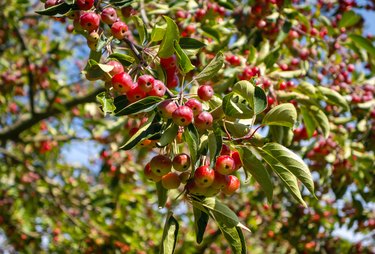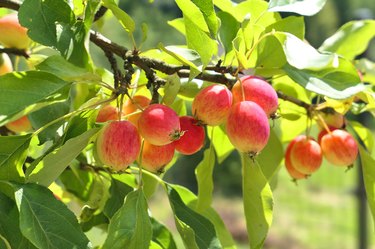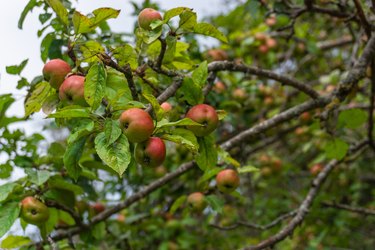Having an apple flowering plant in your yard offers a beautiful burst of spring color and edible fruits. Unfortunately, crab apples and dogs don't mix. Crab apple seeds, stems, and leaves are all toxic to your family pet. While the flesh of an apple, including crab apples, is perfectly safe and even healthy for your pup, don't allow her to eat an entire apple.

Video of the Day
Are crab apples poisonous to dogs?
The seeds of the apple contain the toxin cyanide. While a couple of seeds won't likely harm your dog, if eaten in large quantities, it can cause serious, life-threatening problems. The stems and the leaves of the tree are also poisonous, and the levels of the toxin increase in the leaves as they wilt. Symptoms of ingesting too many apple seeds, stems, or leaves include dilated pupils, red mucous membranes, difficulty breathing, and panting. Dogs can go into shock.
Video of the Day
If you catch your dog snacking on crab apples or if she is showing symptoms of poisoning, get her to the vet right away or call the ASPCA Animal Poison Control Center or Pet Poison Helpline. Don't try to induce vomiting or give any home remedies unless specifically instructed to do so by a veterinarian.
Other crab apple concerns
Removing the core and seeds is important, not just for removing the poisonous part of the fruit but also because dogs can choke on them. The core can also cause blockages in your pup's digestive tract. Although the flesh and skin are nontoxic, they are high in fiber and sugar and can cause digestive upset in some dogs.
Take care when feeding foods that contain apples. Applesauce and apple pie, for example, are both very high in sugar. Apple pie poses an additional danger since most recipes call for nutmeg, which is also toxic to dogs.
How to prevent crab apple poisoning

Ideally, avoid having problems with crab apples and dogs by choosing a different type of tree to plant in your yard where your dog may be left on his own. If there is already a crab apple tree in your landscape, be aware that when the fruits and leaves fall later in the season, your pup may help himself, which can cause serious problems. Block off the area around the tree during this time and make sure to rake up leaves and fallen fruits right away.
You may also encounter a crab apple tree when you are out on walks. Keep your dog on a leash when you know there are potential hazards. If you are walking your dog off-leash, make sure he knows some basic obedience commands, such as "come" and "leave it" so that you can safely draw him away from fallen apples.
How to safely feed apples to your dog
Many dogs enjoy the flavor and crunchy texture of apples and crab apples. They are a nutritious treat that adds antioxidants, fiber, potassium, and vitamins A and C to your dog's diet.

Before feeding your dog apples, wash them thoroughly to remove any pesticides and germs and remove the stem, core, and all seeds. Cut up the apple and offer it to your pup. If she gets an upset stomach, feed her less or consider peeling the apple before giving it to her.
Generally, regular apples are better for this. There are many types of crab apples, and the fruits range in size from about 1/4 to 1 1/2 inches in size. Since they are so small, there won't be much left after you remove the core and seeds from the apple.